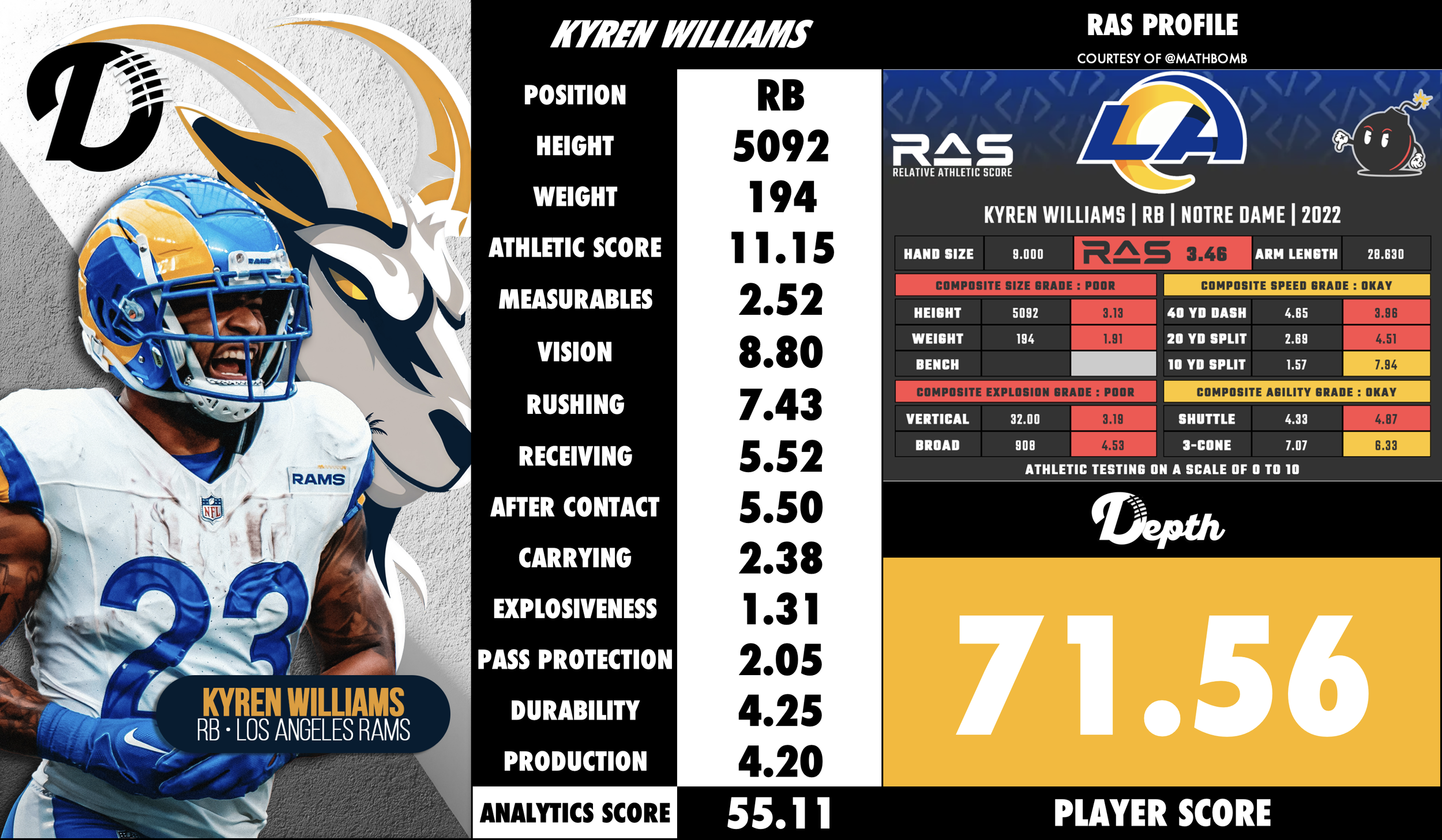
Kyren Williams
Summary
Kyren Williams was selected in Round 5 (#164 Overall) entered the NFL with a blend of vision, agility and receiving‑back capability that appealed to teams looking for a versatile running back rather than just a pure downhill runner. Scouts described him as a “complete” back in college—good between the tackles, effective in space, competent as a receiver—and noted that his size and straight‑line speed were potential limiting factors. Since entering the league, Williams has proven to be more than a depth back, delivering strong production in his first full seasons. His outlook now leans toward being a featured back in certain schemes, with caveats around workload management, durability and usage given his size profile.
Strengths
Excellent short‑area burst and agility: Williams demonstrates quick feet, sudden change of direction and an ability to explode through creases rather than rely purely on straight‑ahead speed.
Vision and patience in the run game: He shows the ability to wait for blocks, make decisive cuts, read flow and exploit open lanes rather than always running first and thinking later. Bleacher Report
Receiving skills and pass‑proficiency: Uncommon for his size, Williams was praised for his ability to catch passes out of the backfield, run routes, and contribute in passing downs—adding weapon versatility. Bleacher Report
Low‑center of gravity and contact balance: While not a big back, his compact frame helps him absorb contact, stay on his feet, and navigate traffic effectively.
Workmanlike attitude, football IQ and production consistency: His college production (over 1,000 rushing yards in back‑to‑back seasons) and evident polish give him a higher floor than many backs of similar size. NFL Draft Buzz
Weaknesses
Size and power limitations for high‑volume every‑down work: At around 5′9″ and under 200 lbs coming out of college, scouts flagged his potential vulnerability in consistently moving piles or absorbing high workloads. Bleacher Report
Top‑end speed and long payoff runs are average: While his burst is good, his straight‑line speed and the ability to consistently break long runs were not rated as elite—limiting some big‑play upside in certain schemes.
Durability and workload risk: Given his size and style of play, there is concern about wear‑and‑tear over time if he becomes a workhorse back. His focus can deteriorate late in games and he has been guilty of some crucial fumbles at inopportune times.
Less ideal as a pure power‑back or between‑the‑tackles thumper without help: While he can handle inside work, when matched up against bigger defenders in heavy‑run schemes, his lack of mass may reduce his effectiveness.
Scheme and role sensitivity: His best value appears when used in multiple roles (running, receiving, motion) rather than as a traditional every‑down between‑the‑tackles back in a smash‑mouth offense. Without that carve‑out, his ceiling may be limited. Bleacher Report
Fit & Outlook
Kyren Williams fits best in an offense that values versatility in its running backs—someone who can run inside and outside, catch passes out of the backfield, contribute in third‑down situations, and exploit space created by motion or mismatches. He is especially effective in systems that use zone‑oriented runs, misdirection, isolations, and reward quickness and vision more than sheer size or high speed. An ideal role would be as the primary back in a committee system, or as the lead back in a scheme built around his strengths rather than against his weaknesses. Looking forward, Williams’ outlook is very positive. His floor is as a strong starting running back who can handle a significant role, be productive in the run and pass game, and remain a key offensive piece. With the right workload structure and supporting cast, his upside is being one of the more complete backs in the league—offering production, versatility and reliability. The primary risks to his trajectory are injury, over‑use, and being placed in a system that expects him to fulfill the role of a traditional power back without mitigating for his size/limitations. If well‑managed, Williams could be a long‑term lead back whose strengths make him a matchup problem.


